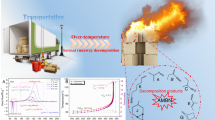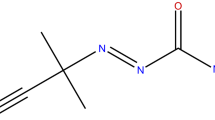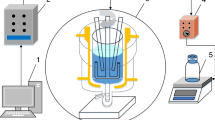Abstract
Peracetic acid (PAA) is potentially harmful because of its thermal hazards in industrial processes. Attention must be paid to the preparation, manufacturing, transportation, and storage because PAA may readily cause a thermal runaway reaction under various upset scenarios. PAA is classified an explosive substance in the governmental regulation in Taiwan. Here, 20 mass% of PAA was used to estimate the thermokinetic parameters by using differential scanning calorimetry. Heating rates employed were 1.0, 2.0, 4.0, and 8.0 °C min−1. We compared the four heating rates of thermal safety assessment with regard to process safety parameters, such as exothermic initial temperature (T 0) and heat of decomposition (ΔH d). Finally, five kinetic analysis methods, along with differential isoconversional kinetic analysis, were used to estimate the apparent activation energy (E a). The experimental results could be used helpful during the manufacturing process, transportation, and storage as the process safety parameter considerations to forestall thermal damage from happening, and to reach zero-disaster purposes as the ultimate goals.








Similar content being viewed by others
Abbreviations
- A :
-
Frequency factor (s−1)
- E a :
-
Apparent activation energy (kJ mol−1)
- f(α):
-
Kinetic functions
- k :
-
Reaction rate constant (mol L−1 s−1)
- n :
-
Reaction order (dimensionless)
- n i :
-
Reaction order of ith stage (dimensionless)
- R :
-
Universal gas constant (8.314 J mol−1 K−1)
- T :
-
Temperature of reactant (°C)
- T max :
-
Maximum temperature of reaction (°C)
- T p :
-
Peak temperature (°C)
- T 0 :
-
Exothermic onset temperature of reaction (°C)
- ΔH d :
-
Heat of decomposition (J g−1)
- α :
-
Degree of conversion (dimensionless)
- α i :
-
Isoconversion degree in various heating rates by Ozawa–Flynn–Wall kinetic equation (dimensionless); i = 1.0, 2.0, 4.0, 10.0
- \(\beta\) :
-
Heating rate (°C min−1)
References
Eto I, Akiyoshi M, Miyake A, Ogawa T, Matsunaga T. Hazard evaluation of runaway reaction of hydrogen peroxide-Influence of contamination of various ions. J Loss Prev Process Ind. 2009;22:15–20.
Chu YC, Chen WT, Tsai FC, Tsai LC, Lin FR, Shu CM. Evaluation unexpected energy released for three liquid organic peroxides. Energy Educ Sci Tech Pt A. 2012;30:977–82.
Jhu CY, Wang YW, Wen CY, Shu CM. Thermal runaway potential of LiCoO2 and Li(Ni1/3Co1/3Mn1/3)O2 batteries determined with adiabatic calorimetry methodology. Appl Energy. 2012;100:127–31.
Wang YW, Liao MS, Shu CM. Thermal runaway hazards for LiCoO2 Li-ion batteries by DSC tests. Energy Educ Sci Tech Pt A. 2012;30:1–4.
Wang TS, Liu SH, Qian XM, Shu CM. Isothermal hazards evaluation of benzoyl peroxide mixed with benzoic acid via TAM III test. J Therm Anal Calorim. 2013;113:1625–31.
Lin JR, Liao MS, Wang YW, Jhu CY, Liu SH, Shu CM. Thermal hazard evaluations of peracetic acid by DSC and AKTS. In: Proceedings of the 6th international conference on process systems engineering (PSE ASIA) 25-27 June 2013, Kuala Lumpur, Malaysia.
OSH-ROM, Major harzard incident data service (MHIDAS). Health and Safety Commission (HSC), UK.
Wang YW, Liao MS, Shu CM. Thermal hazards of a green antimicrobial peracetic acid combining DSC calorimeter with thermal analysis equations. J Therm Anal Calorim. 2015;119(3):2257–67.
Baldry MGC. The bactericidal, fungicidal and sporicidal properties of hydrogen peroxide and peracetic-acid. J Appl Bacteriol. 1983;54:417–23.
Kitis M. Disinfection of wastewater with peracetic acid: a review. Environ Int. 2004;30:47–55.
Hou HY, Liao TS, Duh YS, Shu CM. Thermal hazard studies for dicumyl peroxide by DSC and TAM. J Therm Anal Calorim. 2006;83:167–71.
Lee MH, Chen JR, Shiue GY, Lin YF, Shu CM. Simulation approach to benzoyl peroxide decomposition kinetics by thermal calorimetric Technique. J Taiwan Inst Chem E. 2014;45:115–20.
Li AC, Tsai YT, Wu SH, Chiu CW, Shen SJ, Hsin R, Shu CM. Thermal runaway analysis for two organic peroxides with H2O and dry fire-extinguishing chemicals by DSC and VSP2. J Therm Anal Calorim. 2013;113:1611–8.
Liu SH, Hou HY, Shu CM. Effects of thermal runaway hazard for three organic peroxides conducted by acids and alkalines with DSC, VSP2, and TAM III. Thermochim Acta. 2013;566:226–32.
Weng SY, Liu SH, Tsai LC, Hsieh TF, Ma CM, Shu CM. Thermokinetics simulation for multi-walled carbon nanotubes with sodium alginate by advanced kinetics and technology solutions. J Therm Anal Calorim. 2013;113:1603–10.
Zang N, Qian XM, Liao JY, Shu CM. Thermal stability of lauroyl peroxide by isoconversional kinetics evaluation and finite element analysis. J Taiwan Inst Chem E. 2014;45:461–7.
Augis JA, Bennett JE. Calculation of the Avrami parameters for heterogeneous solid-state reactions using a modification of the Kissinger method. J Therm Anal Calorim. 1978;13:283–92.
Product Information, TAM III Thermostat. www.thermometric.com. 2014.
Tseng JM, Liu MY, Chen SL, Hwang WT, Gupta JP, Shu CM. Runaway effects of nitric acid on methyl ethyl ketone peroxide by TAM III test. J Therm Anal Calorim. 2009;96:789–93.
Townsend DI, Tou JC. Thermal hazard evaluation by an accelerating rate calorimeter. Thermochim Acta. 1980;37:1–30.
AKTS AG. AKTS-thermokinetics software and AKTS-thermal safety software. http://www.akts.com. (2015).
ASTM International. ASTM standard E698, standard test method for Arrhenius kinetic constants for thermally unstable materials using differential scanning calorimetry and the Flynn/Wall/Ozawa method, West Conshohocken, PA, USA. 2013.
ChemInform Saint-Petersburg (CISP) Ltd. Thermal Safety Software (TSS). http://www.cisp.spb.ru/.
Käser F, Roduit B. Prediction of the ageing of rubber using the chemiluminescence approach and isoconversional kinetics. J Therm Anal Calorim. 2008;93:231–7.
Friedman HL. Kinetics of thermal degradation of char-forming plastics from thermogravimetry. Application to a phenolic plastics. J Polym Sci Part C: Polym Symp. 1964;6:183–95.
Lin CP, Chang CP, Chou YC, Chu YC, Shu CM. Modeling solid thermal explosion containment on reactor HNIW and HMX. J Hazard Mater. 2010;176:549–58.
Dellavedova M, Pasturenzi C, Gigante L, Lunghi A. Kinetic evaluations for the transportation of dangerous chemical compounds. Chem Eng Trans. 2012;26:585–90.
Flynn JH, Wall LA. General treatment of the thermogravimetry of polymers. J Res Nat Bur Stand. 1966;70A:487–523.
Ozawa T. Kinetic analysis of derivative curves in thermal analysis. J Therm Anal Calorim. 1970;2:301–24.
Ozawa T. Estimation of activation energy by isoconversion methods. Thermochim Acta. 1992;203:159–65.
Ozawa T. Thermal analysis-review and prospect. Thermochim Acta. 1999;355:35–42.
Wu SH, Su CH, Shu CM. Thermal accident investigation of methyl ethyl ketone peroxide by calorimetric technique. Int J Chem Sc. 2008;6:487–96.
American Society for Testing and Materials (ASTM). E698 Standard test method for Arrhenius kinetic constants for thermally unstable materials. West Conshohocken, PA, USA. 2001.
Ozawa T. A new method of analyzing thermogravimetric data. Bull Chem Soc Jpn. 1965;38:1881–7.
Flynn JH, Wall LA. A quick, direct method for the determination of activation energy from thermogravimetric data. J Polym Sci B. 1966;4(5):323–8.
Koubek E, Haggett ML, Battaglia CJ, Ibne-Rasa KM, Pyun HY, Edwards JO. Kinetics and mechanism of the spontaneous decompositions of some peroxyacids, hydrogen peroxide and t-butyl hydroperoxide. J Am Chem Soc. 1963;85:2263–8.
Yuan Z, Ni Y, Heiningen V. Kinetics of peracetic acid decomposition. Part I: spontaneous decomposition at typical pulp bleaching conditions. Can J Chem Eng. 1997;75(1):37–41.
Acknowledgements
The authors wish to thank Chang Chun Group (CCP), Taiwan, ROC and Ministry of Science and Technology (MOST) of the ROC for financial support of this study.
Author information
Authors and Affiliations
Corresponding author
Rights and permissions
About this article
Cite this article
Chen, WC., Lin, JR., Liao, MS. et al. Green approach to evaluating the thermal hazard reaction of peracetic acid through various kinetic methods. J Therm Anal Calorim 127, 1019–1026 (2017). https://doi.org/10.1007/s10973-016-5812-0
Received:
Accepted:
Published:
Issue Date:
DOI: https://doi.org/10.1007/s10973-016-5812-0




